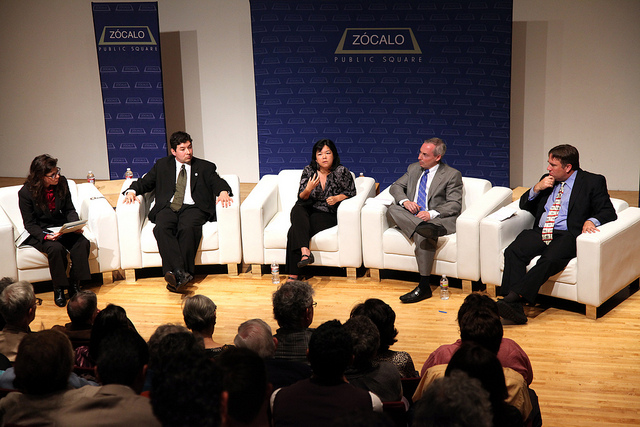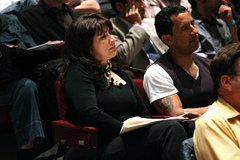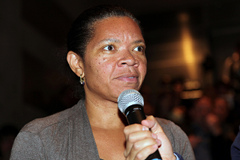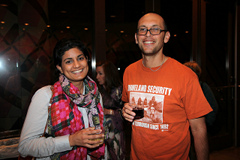
Law professor Jessica Levinson opened a panel on California’s redistricting efforts by quoting panelist Dan Schnur, a veteran political communications strategist and director of University of Southern California’s Jesse M. Unruh Institute of Politics.
“For most normal people, ‘redistricting’ is the most boring word in the English language,” Schnur told the Los Angeles Times last week. “But for members of Congress and state legislators, it’s a cause for full-out panic. … This is musical chairs with switchblades.”
While Schnur stuck by the second part of his statement, he apologized for the first part. After all, Angelenos packed the auditorium and an overflow room at the Museum of Contemporary Art downtown to hear a panel of redistricting experts discuss the topic in depth.
And the panel turned out to be anything but boring, with sharp disagreements and witty quips flying between Levinson and Schnur, plus California Common Cause executive director Kathay Feng, Mexican American Legal Defense and Education Fund (MALDEF) national redistricting coordinator Steven Ochoa and California political expert Joe Mathews.
How We Got Here
 The panelists spent a few minutes at the beginning of the program discussing the changes to California’s redistricting process over time and how they’ve affected state politics. Feng’s organization helped write Prop. 11 and Prop. 20, the two laws that combined to create the California Citizens Redistricting Commission, which released its draft redistricting maps last week.
The panelists spent a few minutes at the beginning of the program discussing the changes to California’s redistricting process over time and how they’ve affected state politics. Feng’s organization helped write Prop. 11 and Prop. 20, the two laws that combined to create the California Citizens Redistricting Commission, which released its draft redistricting maps last week.
Feng said the need for change was obvious when she worked for the Asian Pacific American Legal Center in the 1990s, trying to help disenfranchised groups have their collective voice heard in Sacramento. She and her staff organized large groups of people to testify in front of the legislature about the need to keep their communities together in redistricting, only to see the politicians nod politely, then head into another room to make decisions themselves. As a result, Asian-American neighborhoods were carved up into two and three pieces, limiting the communities’ influence in the capitol.
“We were part of a dog and pony sideshow, and the real thing was happening behind closed doors without any public participation.”
With the creation of the Citizens Redistricting Commission, Feng said, at least groups know their voices will be heard. The commission held 23 hearings around the state before releasing their draft maps and will hold others before the final product is certified in August.
Schnur agreed that politicians should not be allowed to draw their own districts, comparing that notion to letting a teenager set his curfew. He added that no redistricting effort can make every political race competitive, but that if it makes for a dozen more tight races moderates will benefit.
“Not only has the passage of Prop. 11 eliminated the conflict of interest that legislators face, but as a happy ramification what we will see is an increasing number of centrists in the California state legislature and California state senate,” he said.
Not a Silver Bullet
 Ochoa and Mathews took the other side of the issue, arguing that the new redistricting system will not work (for different reasons). Ochoa, whose organization campaigned against Prop. 11 and Prop. 20, said neither redistricting system works.
Ochoa and Mathews took the other side of the issue, arguing that the new redistricting system will not work (for different reasons). Ochoa, whose organization campaigned against Prop. 11 and Prop. 20, said neither redistricting system works.
“At this point in time it looks like we traded one disenfranchising system for another,” he said. “As a person of color working for an organization that tries to empower a traditionally disenfranchised community nationally, redistricting is an opportunity to give voice to the voiceless.”
Ochoa was extremely disappointed in the draft maps: Latinos comprised 90 percent of California’s population growth in the last decade, but the draft map does not add any Latino “opportunity districts,” a prospect he suggested might not be in compliance with the federal Voting Rights Act.
“There are no gains in this first draft, and it’s very, very frustrating,” he said.
Matthews was the least optimistic member of panel about the prospects of redistricting, saying it’s like “giving aspirin to someone with gangrene. It’s fine. It’s brushing your teeth when you have two broken legs.”
Matthews said that the numbers show the new draft maps would not make the vast majority of districts any more competitive and thus not do anything to alleviate the partisan gridlock in Sacramento.
“We’d go from situation in which more than 90 percent of legislative races don’t matter to a situation in which more than 80 percent of legislative races don’t matter,” he said.
Where We Go From Here
 Their disagreements notwithstanding, the four panelists were unanimous in saying the Citizens Redistricting Commission and the new district maps can’t solve all the problems that face California. Feng emphasized that the commission still has much work to do – it must prove it is responsive to citizens and make some changes to the map before it is certified in August.
Their disagreements notwithstanding, the four panelists were unanimous in saying the Citizens Redistricting Commission and the new district maps can’t solve all the problems that face California. Feng emphasized that the commission still has much work to do – it must prove it is responsive to citizens and make some changes to the map before it is certified in August.
Ochoa said that the state needs to make a bigger priority of the Voting Rights Act, the 1965 law that outlawed discriminatory voting practices and is a major factor in any redistricting effort. He agreed with Feng that minority communities must have districts in which they are the dominant population groups in order to ensure representation at the local, state and federal levels.
Mathews countered that no redistricting effort can bring true change to California’s broken political system; only deeper reforms can do that. The state needs to get to the point where “there is real competition everywhere, everyone’s vote matters,” he said.
Schnur sought to bridge the two sides, agreeing with Mathews that the potential benefits of redistricting are limited but that it’s a good start.
“Politics is dirty and it’s messy and its difficult but what redistricting does is … it can’t make change happen, but it can at least create an environment where it can happen,” he concluded.
For event photos, please click here.
For full video, please click here.
*Photos by Aaron Salcido.




Send A Letter To the Editors